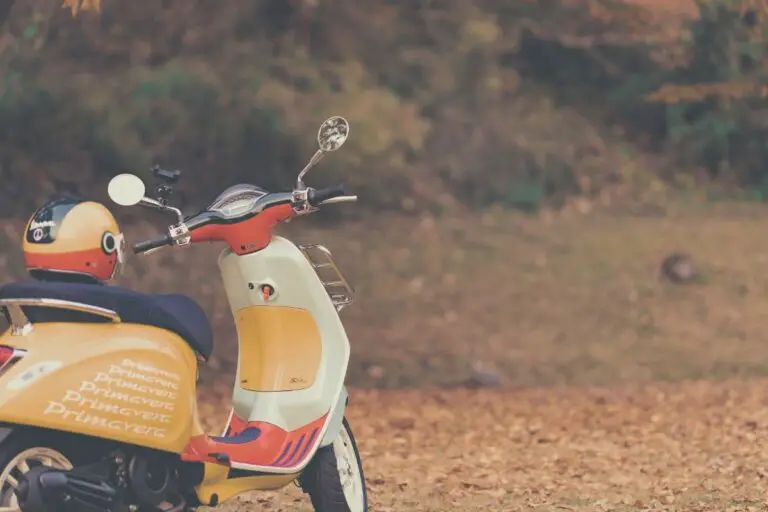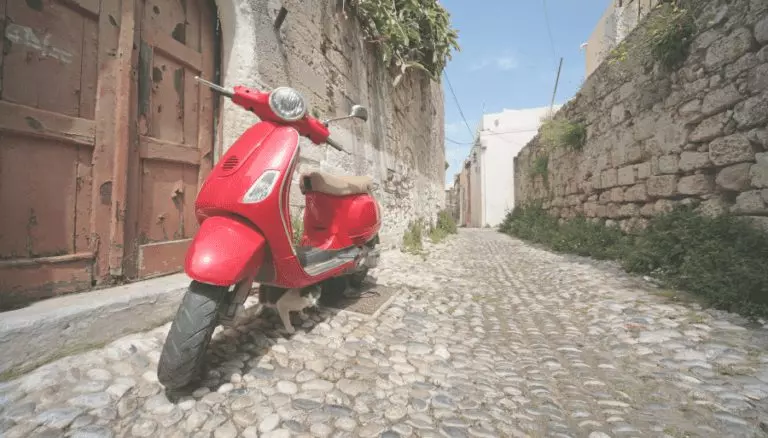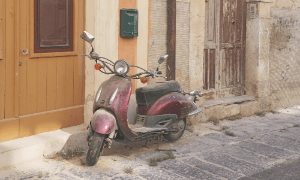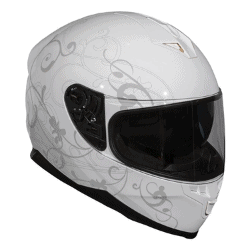While you might not have considered it, it’s pretty important to keep your motorcycle helmet as clean as possible. You want to keep it looking good, but the inside gets pretty funky.
But did you know that you can’t just use any cleaner laying around the house? Yup. Let’s dive into the process, though.
Why You Should Clean More Than the Outer Shell
The inside of your helmet is often in prolonged contact with your skin. This causes sweat and skin oils to transfer to your helmet’s interior lining, which can make your helmet pretty unpleasant to wear after enough time has passed.
Think about the process of putting it on & taking it off. You’re wiping your face oils even without sweat with each pass.
Cleaning your helmet exterior is less important for your personal comfort, but it’s obvious if you want your helmet to look nice.
Over time, you’ll likely find that dead bugs, road dirt, and other ‘stuff’ will start building up on your helmet, and the longer you leave it on, the harder it will be to remove it later.
Cleaning both the outside and inside of your helmet will also help to keep it in good, safe condition for longer.
Today, we’ll be talking all about the cleaning process for the outside and inside of your motorcycle helmet, and you can read more on how to store your helmet here.
First, let’s go over how to clean the outside of your helmet. Depending on how dirty your helmet is, you might want to consider doing either a quick wipe-down or a real deep cleaning. Scroll to which you wanna do.
Quick Wipe Down for Your Motorcycle Helmet
Wiping down a motorcycle helmet is pretty easy and doesn’t take very long. If you can, this is something you should do after every time you wear your helmet for a period of time like after a long ride or a dusty one.
Quick wipe downs will make the bigger helmet cleaning sessions quicker.
What You’ll Need
Clean, plain water and a soft cloth is all you need for this, especially for a quick wipe down.
- Water
- Soft Cloth (I use a microfiber)
- Optional: mild detergent like baby shampoo
And word of caution – be careful with your visor. It is more likely to scratch, so when your cloth is fresh, it might be the best place to start on a quick wipe-down.
Quick Wipe-Down Process
If there are any bits that are really look stuck to the outside of your helmet, you can start by loosening the grime draping the damp soft cloth over the helmet for 10 minutes.
After about 10 minutes, use the cloth to wipe down the helmet (remember to start with the freshest cloth possible on your shield, though)
Quick tip here: Special plastic cleaners are an option, and you can usually use clean and polish the shell with wax EXCEPT on the any ventilation sliders or helmets with a matte finish. Read the label on the cleaner AND from your helmet documentation if you can Google your way to that.
You can use a mild detergent (like baby shampoo) on your damp cloth, but if the quick wipe-down didn’t do it for you, it may be time to jump to the deeper clean.
Deep Cleaning Your Motorcycle Helmet Shell
Got heavier grim on your helmet? This section is for you.
What You’ll Need
| Microfiber cloths | Revzilla | Amazon |
| Mild, non-abrasive soap (like this baby shampoo) | ||
| Visor cleaner | Revzilla | Amazon |
| Anti-fog treatment | Revzilla | Amazon |
| Compressed air * | ||
| Cotton swab* | ||
| Toothbrush with soft bristles* | ||
| Lukewarm water |
You’ll likely have a few of these things around the house, but most of these items can be found locally pretty easily. Links if you need some convenience in your life, but the visor cleaner isn’t easy locally for me in particular.
What Cleaner Should You Use to Clean the Motorcycle Helmet Shell?
Please know that there are different types of plastics. Some are more likely to absorb things that soak the surface than others.
You need to avoid cleaners that are acidic or “alkali-based corrosive cleaning agents”. I’m not a chemist, but what stuck out to me is do NOT use a cleaner like a window cleaner.
In addition, the finish of your helmet comes into play. For example, you can use a wax on helmets that DO NOT have a matte finish.
In general, the safest cleaner to clean your motorcycle helmet is water with or without a mild soap.
You’ll start by removing all the parts that can be removed.
Remove Electronic Components
Once you’ve gathered what you need, start by removing all of the electronic accessories attached to the helmet, if there are any. These include any microphones, Bluetooth communicators, or antennas that you might have installed on your helmet along the way.
Electronics don’t like water!
Remove the Visor (aka Face Shield)
If you’re working with a full-face helmet or a 3/4 with a built in shield, you’ll need to take this off.
If your shield isn’t able to be removed, that’s fine. Your neutral cleaner is ok for those pieces. Be careful with your visor – it’s the most scratchable & impacts your vision while riding.
It is just easier to clean with everything out of your way.
How to Remove the Motorcycle Helmet Liner
Next, you should remove your helmet’s interior lining, if you can. This will make it easier to clean the helmet as a whole.
Most helmets have removable liners, but if you can’t remove the interior lining, then don’t worry about it. Just skip the next section & just bear in mind that this will probably result in longer drying times for the lining.
Clean the Exterior of Your Motorcycle Helmet
Start by getting some lukewarm water & add the mild, non-abrasive soap if you choose. Just water is also fine.
Now submerge & wring out a damp cloth that will cover your helmet. You’ll then lay it over the helmet. This helps soften the crud on it. You can just leave it for now & jump to the inner cleaning instructions or just let it sit for 10 min & come back to this.
Ready? Has it been 10 min? If there are still dried bits, you can certainly wait a bit longer with the damp cloth, but when it’s ready do a quick wipe down.
Just remember – if the visor is attached, BE CAREFUL! I use a clean cloth anytime the visor is in play.
If your helmet has nooks and crannies, use a toothbrush that is lightly wet to help clean those vents and such.
If there’s anything stuck in your helmet’s vents or channels, compressed air can help remove it, too. One of those cans or your garage air compressor if you’re comfortable.
Just be careful as you don’t want to damage the helmet with too much pressure!
Another option for the nooks and crannies is to use a cotton swab like the around visor mechanisms and vents – particularly if the toothbrush didn’t quite clean the way you hoped.
Now, to clean the face shield. Most motorcycle face shields these days are treated with some kind of anti-UV coating and using a cleaning product on the face shield can strip this coating off.
For this reason, this is the spot that you should only ever use warm water when cleaning your helmet’s face shield. It’s just safer!
Follow the directions on the visor cleaner you choose.
Once I’ve cleaned the face shield, I’ll also refresh anti-fog coating on my visor, and again – follow the instructions of what you use. Take extra care with that visor!
Cleaning the Inside of Your Helmet
There are a couple of ways you can clean the inside of your helmet, depending on if the interior lining is removable or not. Let’s take a look at both of these ways.
Cleaning if Your Liner Can Be Removed
If your interior lining, cheek pads & such can be removed, the best way to clean it is to put it in a mesh garment bag and then wash it in your washing machine using the delicate cycle using a very mild detergent like Woolite (that you may already have at home).
Again, anything you use should be gentle, including the laundry detergent you use.
When the lining is done washing, take it out of the machine right away and let it air dry.
If you want it to dry a little faster, I like to point a fan at it. This will keep it from smelling sour & speed up the time to when you can use it. Get to ride faster!
Do not dry your helmet lining in the dryer or with a hairdryer; the heat generated by both of these appliances can melt the glue that holds the lining together & you may break down the foam padding faster.
Cleaning if Your Liner Can NOT Be Removed
If you can’t remove the lining of your helmet, or you can only remove some parts of it, start by taking off whatever you can. Then, grab a bucket of warm, soapy water, and start scrubbing the interior of the helmet liner.
To keep things simple, just work on one section of the lining at a time.
Next, you’ll want to get the soap out of the lining. To do so, get a fresh bowl of clean, warm water, and scrub out all the sections of the helmet again. Don’t worry about really soaking the helmet during this step; it will dry eventually, and the important thing is to make sure that all the soap is removed.
To dry your helmet, get some dry cloths or towels and press them against the lining until no more excess water comes out. It will probably still be a bit damp at this point, so leave your helmet in front of a fan to finish drying.
The fan is super important to me if I’m hand washing a liner that can’t be removed because a super wet helmet liner takes longer to dry overall, and I don’t want to run the risk of it smelling badly if it takes too long to dry!
Tips on Storing Your Motorcycle Helmet
Storing your helmet in the right place can help keep it cleaner longer and likely help you get the most out of it before you need to replace it.
Read more: 6 Helmet Storage Options [+ Why it matters]
You probably just take it off & put it where it’s convenient, but take a moment to consider these tips:
- No direct sunlight!
- Don’t store it on your seat. Please! I see this all the time.
- No nearby heat source
- Keep it upright versus upside down
Keep Your Helmet Clean
You can always keep your helmet cleaner by storing it well. Read here for ways to store your motorcycle helmet for more options and in-depth tips.
Did you know motorcycle helmets can ‘go bad’? That’s relative when compared to milk, but they do become less effective if neglected, kicked around, or just through aging. Read more: Know when to replace your motorcycle helmet.







